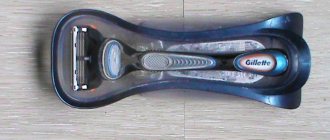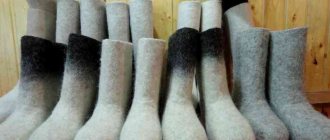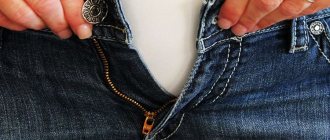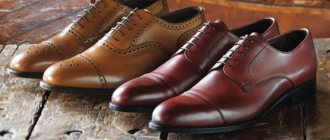Despite the large number of types of winter and demi-season shoes, felt boots do not lose their relevance. These are very warm, comfortable and practical products that will keep you warm in any frost. These shoes are made from felted sheep wool. Children's felt boots are especially popular, because in such shoes a child’s feet are always warm. At the same time, they do not sweat and remain comfortable.
During use and wear, the shoes gradually stretch on their own, but sometimes this does not happen, or the felt boots shrink completely due to improper care and use. If the products are shrunk or shrinking, you should not distribute them in the usual way. Traditional methods of stretching shoes using special sprays and aerosols will not work either.
Classic stretching agents are only suitable for leather or suede shoes. And for felt boots, they will not bring results, but they can spoil and deform products made from natural wool, and will also bring discomfort during wear and use. Let's find out how to stretch felt boots at home without harming the material.
How not to handle felt products
Let's look at what is prohibited in relation to felt products:
- To soften felt boots, you shouldn’t heroically try to wear them out through the pain. This rash step will end in damage to your feet in the form of calluses and wounds.
- Under no circumstances use products intended for the care of leather and suede shoes.
- Drying should not be done near batteries, because felt products may become deformed.
If previously felt boots were only suitable for the garden or fishing, today ladies in felt boots with appliqué or embroidery can also be found at fashionable parties.
Children will also like them, and they will not be superfluous in a country house. Indispensable winter shoes, an example of comfort - these are all our felt boots! Wear it with pleasure!
Crocs size chart
What style of trousers will help hide full hips?
How to properly clean felt boots
Felt boots should never be washed and it is not recommended to wash them in water too often, otherwise you will irreversibly damage the appearance and shape of the products. In addition, they can shrink several sizes at once, after which you will not be able to widen the shoes. After wearing the felt boots, remove snow, dirt, sand and salt using a stiff or metal brush.
The shoes are then dried in a warm and dry place. You can put the products on a warm radiator, but you cannot put shoes on a hot surface. You can dry a pair of shoes at room temperature by filling each item with dry newspaper or paper. This is the most gentle and safe drying method, which is suitable for every type of shoe. Read more about how to dry your shoes properly and quickly here.
After drying, brush the items again to remove any remaining dirt and sand. If stains remain on the surface, dissolve the washing powder with water in a ratio of 1 to 2. Using the prepared mixture and a brush with stiff bristles, clean the dirty areas.
The foam that has formed on the surface of the products is washed off under a light stream of cold water. Then the shoes are dried only under natural conditions at room temperature, away from sunlight, batteries and electrical appliances. By the way, large lumps of dirt can be vacuumed.
Soap foam is suitable for cleaning dark and light felt boots. On dark products, stains can also be removed with a dry crust of black bread. In addition, this treatment will return the shoes to their former attractive appearance. The remaining crumbs are removed with a brush.
To clean white or light felt boots, take flour, starch, tooth powder or semolina. Sprinkle the selected composition evenly over the material and rub in using circular movements. Remove any remaining product with a brush.
In addition, white felt boots can be wiped with a sponge soaked in carpet care product. Vanish is perfect. To prevent felt boots from becoming deformed and shrinking, you need to choose the right products and organize proper shoe care.
How to prevent deformation of felt boots
- Choose models with soles and a comfortable last. Then the products will not have to be stretched. In addition, the sole will prevent boots from getting wet in damp weather or when snow melts in a warm room;
- For felt boots with regular felt soles, take one size to the next. For products with rubber soles, choose a size larger;
- Wear products with medium firmness. Felt boots that are too rough will pinch, and soft ones will quickly lose their shape. The most comfortable shoes are considered to be made from comb, fine-wool wool of the highest grade;
- If you choose new felt boots without soles, you can hem the sole yourself. By the way, this is much more convenient to use than using classic galoshes. As a sole, you can take a thick layer of felt and sew it with threads;
- Do not wear felt boots in damp and warm weather. It is not recommended to wear these shoes without soles or galoshes in temperatures warmer than minus seven degrees;
- Do not wash your felt boots and wash them using water only as a last resort. After each wear, be sure to clean off wet snow, dry the products and sweep away dirt, sand or salt from the street with a brush;
- You can use specialized water-repellent shoe care products for cleaning. Treat the surface with protective compounds. This will prevent the negative effects of humidity and dampness, keep the material dry and create an invisible barrier against dirt;
- When performing general cleaning of felt boots with decorative elements, it is better to rip off the patch, decorations or embroidery and clean the parts separately.
What are felt boots made of?
These are warm boots made of felted sheep wool . They are shoes for walking on snow . There are both hard and soft ones, which are worn under other shoes. Let's look in detail at how to soften these shoes.
To soften felt boots, take:
- Thick yarn socks.
- Unnecessary paper or newspapers.
- Polyethylene.
- Drying oil.
- Wooden blocks.
- Rubber hammer.
- Laths.
Fast and reliable method
If the soles of the felt boots are a little smaller, wooden blocks that fit the size of your feet will help. You can buy them, make them yourself from a whole log, or using the typesetting method. Insoles cut from thick boards are a great option. All sharp edges of wooden parts should be rounded so that they do not deform the product. It is better to cover finished devices with drying oil to increase their service life. An alternative is foam pads. They must be placed inside felt boots when stored in the off-season. In this form, the shoes are guaranteed not to shrink or become deformed.
How to quickly break in tight or new shoes
Probably everyone has found themselves in a situation where purchased shoes, which seemed to be chosen without haste and fit perfectly on the foot, turn out to be tight and uncomfortable to wear. Even if you know the rule that it is better to buy new shoes in the afternoon, when your feet are already slightly swollen, there are cases when the model itself is too narrow or you have non-standard feet.
In a word, there can be many reasons, but it is not at all necessary to endure unbearable torment, pain and rubbing calluses until the new shoes stretch when worn.
Stretching is necessary in the following cases:
- the shoes turned out to be small because the store did not have the right size;
- too tight in width, although ok in length;
- The width fits perfectly, but the length is too tight;
- became smaller after rain (for example, suede);
- gets cramped at the end of the day.
How to quickly break in new tight shoes
When a callus appears in the heel area, wearing a regular bactericidal patch on the area of redness for two or three days helps in most cases. During this time, the front part of the shoe wears out a little, and the load on the heel is noticeably reduced.
Prolonged wearing of the patch can also help when there is discomfort in one of the toes. The bactericidal patch has an additional thick layer that promotes greater stretching of shoes in a certain place.
In the case where the callus is already a fait accompli, the use of a patch is doubly justified.
If your shoes are too small: four universal tips
Way #1
First of all, you can turn to a shoe specialist for help. Workshops almost always have special stretching devices. If you think you need it, you can purchase a shoe stretcher and do it yourself at home.
Method No. 2
There is also a special product for stretching shoes on sale. It is suitable for all types of materials except patent leather. This is perhaps the most effective way.
You can find it in any department specializing in shoe care products.
As a rule, this is a special liquid composition. You can ask the seller or read on the packaging about how to use the solution, but most often it is enough to moisten a cotton swab and apply the product to the area that rubs your leg.
Wearing thin cotton socks, walk around in the treated shoes for about 40 minutes.
If your stretching agent comes in the form of a spray, you can use it to treat the inside of your shoes. Again, after treatment, you need to wear shoes for about 40 minutes, putting socks on your feet.
Suede products come in the form of foam; The principle of use is similar to the previous one. After treating the suede product from the inside, you stuff it tightly with newspapers or wear it around the house after putting on socks.
What to look for when choosing high boots?
You can understand how to choose high boots from a kamus by understanding the details. Pay attention to the cost of shoes, because models made from natural materials cannot be cheap. The average price range varies between 3,000-5,000 rubles - in this case, the fur will be real, not artificial. In general, fur is an advantage of high boots, so you should look at it first. There are often fakes on sale made from the skins of cows or horses - they are cheaper, but less warm.
How to properly store felt boots
Before long-term storage, thoroughly clean and completely dry your felt boots. The products are placed in a plastic bag and tied well. The package is placed in a warm and dry place. During long-term storage, periodically check the products and leave them to dry in the sun. The main danger in this case is moths, which can leave small holes in felt boots.
To protect your felt boots from moths, store your shoes separately from wool and fur items. Store only dry and clean items. For long-term storage, put a special anti-moth product in a plastic bag or place the products in special cases with anti-moth impregnation. In addition, you can treat the felt boots themselves with anti-moth solutions and aerosols.
Among folk remedies, herbs with aromas of lavender, mint, oregano and wormwood are used. Fresh orange and lemon peels help, which need to be replaced as they dry out. If you do notice traces of moths, put the shoes to dry in the sun and leave for 4-6 hours.
Under the sun's rays, the moth larvae will die, and the remains can be removed with a brush. For more information on how to properly store things and get rid of moths in the closet, read the link.
An easy and affordable way
A popular method of stretching shoes is based on the ability of frozen water to expand and increase in volume. Thick plastic bags or a durable balloon are filled with liquid and placed inside felt boots. They are left in the cold overnight. Then the products must be dried well. are also used to stretch felt boots . Wet shoes are stuffed very tightly and left to dry.
Stretch natural felt boots using a ball chamber. It is placed inside and inflated. It is important not to forget about the boot. You should find a suitable plastic bottle for it or fill it with paper. All these methods stretch the shoes slightly at one time. Therefore, to achieve greater effect, the procedure must be repeated many times.
Changing the size of felt boots
So, on a frosty, sunny winter day, a young man with a completed higher technical education gathered with friends in the forest: to take a walk, sit by the fire, and breathe in the smoke. I took out my felt boots from the storage room, which had been lying there inactive for three years, and prepared them for a walk. On the way to the forest I felt as if the size of my felt boots had become smaller. When the felt boots were bought, they were spacious and comfortable, but now they are too small. I thought that my legs had gotten fat and that my felt boots were getting worn out during the walk. However, this did not happen. The young man barely dragged himself home, rubbing several very painful calluses along the way.
The caring wife said that rather than wear such harmful felt boots, it would be better to buy new ones. But it’s a pity to throw away the thing, and, besides, it’s not the felt boots’ fault that their owner left them unattended for a long time (that’s why they shrank from boredom).
Therefore, the decision was made not to throw away the felt boots, but to stretch them and mold them to fit the leg. But how? The late village great-grandfather would have solved the problem in some simple way, but here you have to think for yourself.
It turned out that it was useful to think: I remembered a picture from a cheat sheet on theoretical mechanics with an image of a sine crank-slider mechanism:
In this mechanism, rotation of the crank R causes translational movement of the slider A from the axis of rotation of the crank. The greater the angle of rotation "phi", the greater the force F developed by this mechanism. So this is exactly what you need: the felt boots can be stretched according to the principle of a sinus crank-slider mechanism!
It is necessary to place a mechanism made of planks with a crank R and a slider A inside the felt boots:
No sooner said than done. Two cranks in the form of insoles are cut out of scraps of an inch board with a hacksaw and a knife. Insoles from rubber boots are used as a template for them, since there are no complaints about their size: they are quite spacious and can be worn with warm foot wraps.
The backs of the semicircular shaped pads are sawed off. Two holes are drilled in the corners of the shortened tail, ropes are threaded into these holes, the ends of which are tied. Now blocks 1 (Fig. below) are equipped with rope handles.
Next, a round pine block of wood is split in half, and two half-cylinder stops 2 (sliders) are obtained. To influence the crank-slider mechanism, take a block (log) 3 longer than the top of the felt boot by 20-25 cm.
You can start stretching your felt boots. Felt socks are pre-soaked in hot water (over the sink) for a few seconds. Insole pads are inserted into the felt boots (which should fit there under sufficient force).
Then the backs of the shoes are lifted using the rope handles and semi-cylinder sliders are pushed along the back walls of the felt boots to the very soles. All that remains is to tap the end of the log on the insoles and hammer them down to the soles, as shown in the figure.
In this state, the felt boots are placed next to the radiator to dry. The next morning, all the pieces of wood are removed from the felt boots and the owner’s legs are inserted in their place - the legs turn out to be just like at home!
After a many-year break, old Russian shoes - felt boots - are coming back into fashion. Unfortunately, they have one not very pleasant feature. Over time, felt boots shrink and decrease in size. Therefore, after a year or two, their lucky owners begin to look for tips on how to stretch felt boots at home. It turns out there are many simple options.
Special chemicals
If you are a fan of more modern methods, you will definitely find specialized means for increasing your shoe size.
They are available in the format of sprays, gels and even foams. You can look for these shoe cosmetics in branded stores or in markets selling household chemicals.
Algorithm of actions
- Apply the product to clean and dry shoes from the inside and outside.
- Put on your shoes and zip up if there is one.
- Walk around the house in your shoes for a while, waiting for the product to be absorbed into the material and dry.
- If necessary, the procedure can be repeated several times.
Guaranteed result
The stretching mechanism is easy to make yourself. It consists of three parts: toe, heel and wedge. To make it, you will need a dry log with a diameter of about 14 cm. Its length should be equal to the size of the foot in cm minus 7 cm (radius of the log). It is cut lengthwise into two equal halves. The sock needs to be rounded to the shape of the front of the felt boot and placed horizontally inside. The heel half is slightly cramped so that it is convenient to drive the wedge, and is located vertically at the back wall of the felt boot. A spacer is driven between them.
For the second option, two bars are selected. The first is the length from the toe to the plumb line of the front of the boot. The heel part is shorter. In total, they should be 5 cm smaller than the size of the foot. A nut and an M16 bolt are attached to the toe part. A metal stop and a well for the heel are installed in the heel half. The second movable nut is rotated using a wrench and changes the distance between the bars.
Increasing the size of felt boots
Before you start stretching, you need to familiarize yourself with some important rules that may help you avoid mistakes in the future. When dealing with such fragile natural shoes, it is worth studying this topic in more detail.
- You cannot wear felt boots on your feet like regular shoes. Due to their rigidity, they can cause serious harm to the feet and fingers, but it will still not be possible to spread them in this way.
- Often the procedure is required for people who have no idea how to stretch felt boots at home. If you decide to do this for the first time and do not have the appropriate tools at hand, you should not “reinvent the wheel” by solving the problem with improvised means. The nearest shoe shop won’t charge you a lot of money for stretching, but the result is guaranteed to be positive.
- Particular attention should be paid to drying felt boots. They often become smaller due to moisture. When drying them on the radiator, it is necessary to place bottles of water in the toe and boot, then the shoes will not lose their original shape.
Important nuances
To ensure that the product does not deform, you should follow simple rules. Before starting work, felt boots must be thoroughly soaked. There are several options for this:
- steam in a water bath;
- place in a container with boiling water;
- hold over the sink under hot water.
It is recommended to stretch warm felt boots carefully, in several stages. From time to time you need to tap with a rubber mallet or rolling pin on the surface of the sole and foot. This technique will make the product softer and allow the felt boots to be stretched correctly , evenly in all directions.











